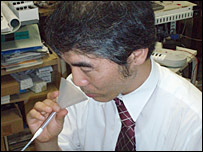Avi Blizovsky

A scent recorder may be used in the perfumery industry
The scent recorder uses a neural network to learn the scent recipes.
The first thing you feel when you enter Takamichi Nakamoto's laboratory is a smell. The smell of fried meat with onions, the spicy smell of Japanese curry and even the disgusting smell of a boiled egg - all these smells merge together in the small room.
However, the stench is not the product of a disheveled professor surrounded by leftover meals he grabbed during a marathon experiment. Instead, the smells originate from the professor's work.
Professor Nakamoto, from the School of Engineering at the Tokyo Institute of Technology builds a wide variety of gadgets and sensors that can smell, mix and emit a variety of hundreds of scents. One of the most ambitious devices his team has built is a sophisticated "odor recorder," which can smell a bone and then reproduce its odor using a variety of chemicals.
If the recorder is presented with a bright red apple, its electronic nose will smell, analyze the smell and develop a recipe of chemicals needed to recreate the smell. When you want to bring up the smell again, the device mixes the ingredients and emits the smell of the apple back.
"Our goal is to enable the reproduction of all smells," said Prof. Nakamoto. "So in this case we combine two technologies - smell detection and smell production." At this stage, the prototype can reproduce only a few types of smells including apples, bananas, oranges and lemons, but synthesizing billions of different smells is still a problematic operation, Prof. Nakamoto admits. There is no small number of "basic" scents from which all scents can be created, as is the case, for example, with the topic of colors on television. Instead, Nakamoto and his team will be forced to load the machine with nearly a hundred vials of chemicals chosen for their odor close to one of the target odors, which the machine mixes in different concentrations.
The device doesn't necessarily mix the right recipe on the first try, instead it learns the correct ingredient list by comparing and analyzing the target smell with the dish over and over again. The recorder learns the recipes through the use of a neural network, a collection of computer processors that function in a similar way to the brain of a simple animal.
The system has received interest from several parties in the perfume industry. Two senior executives from the industry participated in the presentation made by the professor. In the end, says the professor, a smell recorder can replace the "professional nose" of the perfume industry - people whose sense of smell is so developed that their job is to check the consistency of groups of smells. The flavoring industry is also interested in the machine.
Other possible uses could be for e-commerce where customers can smell fresh products before purchasing them, or to help doctors diagnose patients remotely. One of the uses of the machine may be to create smells for a virtual reality environment. Nakamoto's group recently developed a computer game that produces smells that match the activity on the screen. This is a game about cooking, and in it you have to mix virtual ingredients into a mold on the screen that cooks a Japanese curry. As you add butter and onion, the realistic smells come out of the device. Later, garlic, meat and spices are added to complete the dish.
Revision
Prof. Nakamoto admits that the demonstration is still worthless but says that the concept may be important for improving distance learning. "When you present something together with its smell, it improves the memory," he said. For example, an elementary school student learning English can see the word apple in front of him. If this is presented along with the smell, it will be easier for students to remember the word.
Smellovision has been tried many times since the XNUMXs and was recently shown in Japanese cinema as an accompaniment to Colin Farrell's film, The New World. This field may also enter the mainstream. Nakamoto's team also developed a scent system that accompanies a series of scenes from the popular Japanese animated film Spirited Away. In one of the scenes, the parents of the main character of the series devour a lot of food and then they turn into pigs. This scene was enhanced by the smells of Chinese food, tofu and at the end of the scene the smell of a pigsty is emitted. A questionnaire distributed among the scouts showed that they paid more attention to details when they carried a bolt. "With the same technology, we can also add a scent to the television and even to the DVD." said.
Of course, for that it will be necessary to minimize the machine which today is too big for a living room. When this happens, a new dimension will be added to television, especially to the sumo fights, or to the more subtle aspects of the nature films.
https://www.hayadan.org.il/BuildaGate4/general2/data_card.php?Cat=~~~608203215~~~80&SiteName=hayadan
